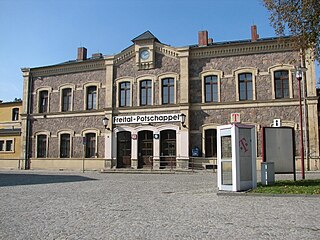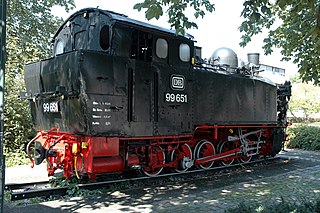
Radebeul is a town in the Elbe valley in the district of Meißen in Saxony, Germany, a suburb of Dresden. It is well known for its viticulture, a museum dedicated to writer Karl May, and a narrow gauge railway connecting Radebeul with the castle of Moritzburg and the town of Radeburg. The Meißen area, where Radebeul is located, is one of the northeasternmost areas where wine is grown in the 21st century.

The Radebeul–Radeburg railway, also known as the Lößnitzgrundbahn and locally nicknamed the Lößnitzdackel, is a 750 mm gauge narrow gauge steam-hauled railway in the outskirts of Dresden, Germany. It should not be confused with the Lößnitz Tramway, known in German as the Lößnitzbahn or the Lößnitzschaukel, which was a metre gauge interurban tramway that connected Dresden with Radebeul.

The narrow-gauge railways in Saxony were once the largest single-operator narrow-gauge railway network in Germany. In Saxony, the network peaked shortly after World War I with over 500 km (311 mi) of tracks. At first, it was primarily created to connect the small towns and villages in Saxony – which had formed a viable industry in the 19th century – to already established standard-gauge railways. But even shortly after 1900, some of the railways would become important for tourism in the area.

Dippoldiswalde is a town in Saxony, Germany, part of the Sächsische Schweiz-Osterzgebirge district. It is situated 23 km east of Freiberg, and 18 km south of Dresden.

The Fichtelberg railway is a 750 mm narrow-gauge railway that leads from the standard-gauge international line at Cranzahl to the ski resort of Oberwiesenthal in the Ore Mountains in eastern Germany. It takes its name from the Fichtelberg Mountain near Oberwiesenthal.

The Weißeritz Valley Railway is a steam operated narrow gauge railway in Saxony, Germany. The line connects Freital, near Dresden, with the spa of Kipsdorf in the Ore Mountains, and follows the valley of the Red Weißeritz.

The Dresden S-Bahn is a network of S-Bahn-type commuter train services in Dresden and the surrounding area. It is commissioned by Verkehrsverbund Oberelbe (VVO) from DB Regio Verkehrsbetrieb Südostsachsen and currently consists of three services operating over a 127.7 km-long (79.3 mi) network.

The German Class 99.73-76 engines were standard locomotives (Einheitslokomotiven) in service with the Deutsche Reichsbahn for Saxony's narrow gauge railways. Together with their follow-on class, the DR Class 99.77-79, they were the most powerful narrow gauge locomotives in Germany for the 750 mm track gauge.

The steam locomotives of DR Class 99.77–79 were ordered by the Deutsche Reichsbahn in East Germany after the Second World War. They were narrow gauge locomotives with a 750 mm rail gauge and were built for the narrow gauge lines in Saxony. The locomotives were largely identical to the DRG Class 99.73–76 standard locomotives (Einheitslokomotiven) built in the 1930s. To differentiate them from their predecessors they were described as Neubaulokomotiven or newly designed engines.

The Saxon IV K were narrow gauge, 0-4-4-0T Günther-Meyer type steam engines built for the Royal Saxon State Railways with a track gauge of 750 mm. A total of 96 were built between 1892 and 1921, making the Saxon IV K the most numerous narrow gauge locomotive in Germany. In 1925 the Deutsche Reichsbahn grouped these engines into their DRG Class 99.51–60.

The Verkehrsverbund Oberelbe is a transport association run by public transport providers in the Saxon Elbeland area of the German state of Saxony. The VVO area comprises the city of Dresden, together with the districts of Meißen and Sächsische Schweiz-Osterzgebirge, and the north-western part of the district of Bautzen.

The Heidenau–Kurort Altenberg railway, also known in German as the Müglitztalbahn is a German railway in Saxony. Branching off the Elbe Valley Railway, it connects the town of Heidenau near Dresden with the towns of Glashütte and Altenberg in the Ore Mountains, where it terminates. The total length is 38 km, with a total incline of 634 meters. The scenic track follows primarily the Müglitz river, passing the towns of Dohna, Glashütte and Geising.

The Friedewald train collision was a railway accident on 12 September 2009 in Saxony, Germany. It involved two steam-hauled passenger trains of the narrow gauge heritage Radebeul–Radeburg railway. One hundred and twenty-one people were injured, four of them seriously. Substantial damage was sustained by the locomotives and rolling stock.

The Vejprty–Annaberg-Buchholz railway is a branch line in the Czech Republic and the German state of Saxony. The line extends the Chomutov–Vejprty/Reitzenhain railway at Vejprty (Weipert), crossing the Czech-German border and running via Cranzahl to Annaberg-Buchholz. It has been operated since 2001 by Erzgebirgsbahn, which is part of DB Regio.

The Lößnitz tramway was a 1,000 mm interurban tramway that connected Dresden with Radebeul in the German state of Saxony. It should not be confused with the Radebeul–Radeburg railway, known in German as the Lößnitzgrundbahn or Lößnitzdackel, which is a 750 mm gauge steam railway.

Radebeul Ost (east) station is a station in the Große Kreisstadt of Radebeul in the German state of Saxony. It is in the suburb now called Radebeul-Ost. The station buildings are located within the boundaries of Alt-Radebeul on Sidonienstraße. The station is on the Dresden S-Bahn network.

Freital-Potschappel station is a station on the Dresden–Werdau railway in the district of Potschappel of the municipality of Freital in the German state of Saxony. From 1884 to 1972, the station was the starting point of the 750 mm gauge Freital-Potschappel–Nossen railway. Today, Freital-Potschappel serves in particular as an access point to line S3 of the Dresden S-Bahn.

Zittau station is a railway station in Zittau, Germany. The station is located on the Liberec–Zittau, Zittau–Löbau and Zittau–Hagenwerder standard gauge lines as well as it is one terminus of narrow gauge Zittau–Kurort Oybin/Kurort Jonsdorf railway. Until 1945 narrow gauge Zittau–Hermsdorf railway to today's Bogatynia in Poland and Heřmanice in the Czech Republic also began at Zittau station.

The Saxon VI K were a class of 750-mm gauge 0-10-0T locomotives of the Royal Saxon States Railways with a gauge of 750 mm. In 1925 the Deutsche Reichsbahn (DRG) grouped the locomotives into class 99.64–65; from 1923 to 1927 the procured more locomotives of this type which were grouped in to class 99.67–71.



















